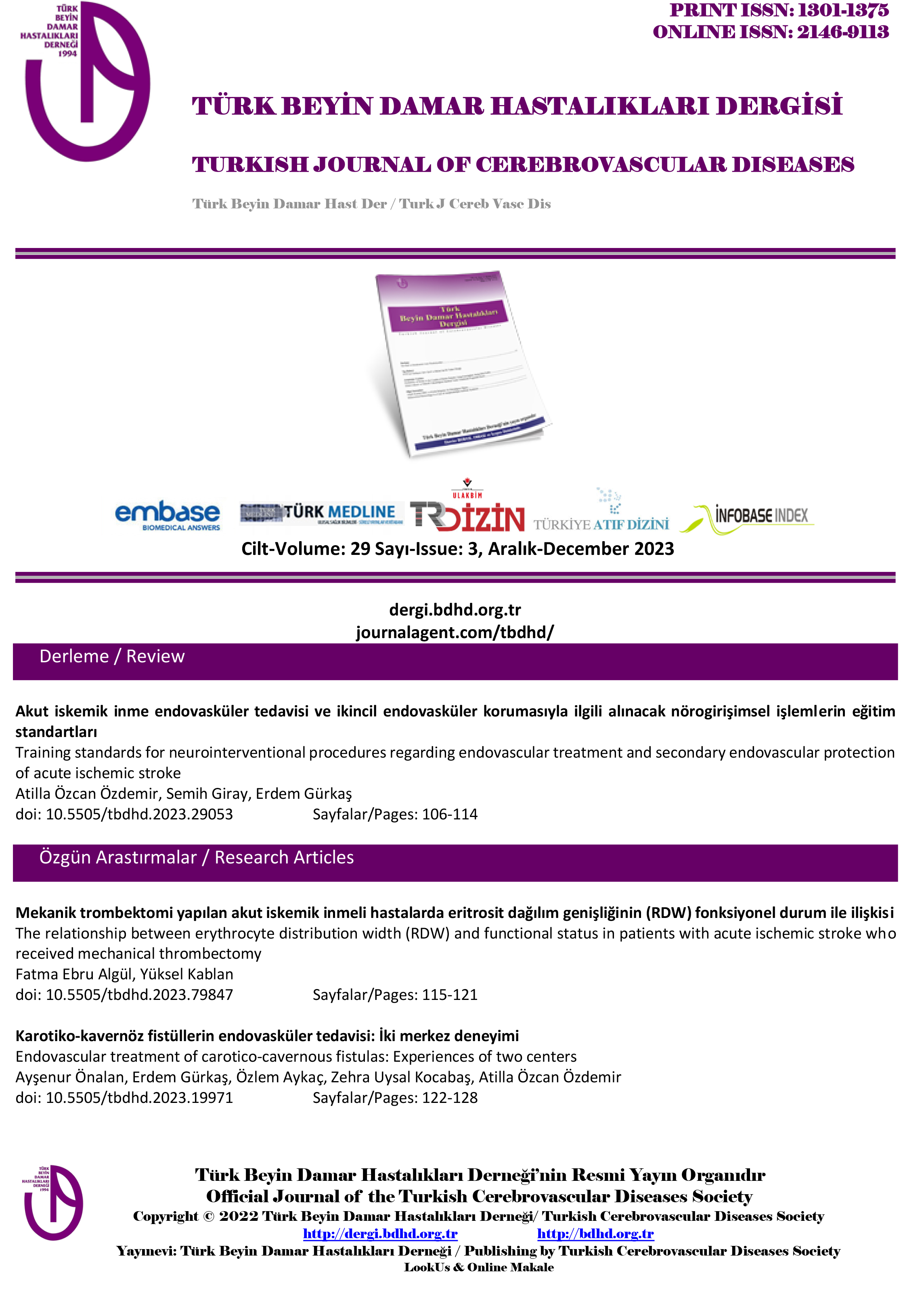Non-motor symptoms in stroke patients
Ümit Görgülü1, Recep Dönmez2, Hesna Bektaş31Ankara City Hospital, Neurology Clinic, Ankara, Türkiye2Aksaray Training and Research Hospital, Neurology Clinic, Aksaray, Türkiye
3Ankara Yıldırım Beyazıt University Faculty of Medicine, Ankara City Hospital, Neurology Clinic, Ankara, Türkiye
INTRODUCTION: Recognition of any symptoms that may develop after stroke improves the quality of life of the patient and their relatives and is associated with a good prognosis. In our study, we aimed to investigate the frequency and characteristics of non-motor symptoms in post-stroke patients.
METHODS: Patients who had a stroke in the last 1 year and recovered well or with mild disability (mRS 0-2) and healthy volunteers as the control group were included in our study. The "Turkish Version of the Non-Motor Symptoms Scale" (NMSÖ-TR) questionnaire consisting of 30 questions was applied to the subjects who met the inclusion criteria, and the results were compared between the two groups.
RESULTS: In our study in which 54 stroke and 116 healthy volunteers were evaluated, the mean age of the stroke group was 59 (36-86) and 39 patients (72.2%) were women. In healthy volunteers, the mean age was 53 (24-77) and 61 (52.6%) were female. The mean NMSS scores were 6 (1-24) in the stroke group and 9 (0-24) in healthy volunteers, and no significant difference was found between the two groups. The most common non-motor symptoms in the stroke group were nocturia (67%), urinary urgency (48%), feeling sad (48%), incomplete bowel emptying (39%), amnesia (37%), Decreased/increased libido (37%), problems with sex (37%). Statistically significant dysphagia (31.5%, p=0.011) and unpleasant sensation in your legs at night/craving to move (50%, p=0.041) were detected more frequently in the stroke group.
DISCUSSION AND CONCLUSION: Post-stroke non-motor symptoms can be observed frequently, even if patients show a good recovery process. The treatment process to be guided by the early detection of these symptoms in the rehabilitation process is important for an increase in the quality of life and a better prognosis.
İnme hastalarında non-motor semptomlar
Ümit Görgülü1, Recep Dönmez2, Hesna Bektaş31Ankara Şehir Hastanesi, Nöroloji Kliniği, Ankara2Aksaray Eğitim ve Araştırma Hastanesi, Nöroloji Kliniği, Aksaray
3Ankara Yıldırım Beyazıt Üniversitesi, Tıp Fakültesi, Ankara Şehir Hastanesi, Nöroloji Kliniği, Ankara
GİRİŞ ve AMAÇ: İnme sonrası gelişebilecek her türlü semptomun tanınması, hasta ve yakının yaşam kalitesini artırır ve iyi prognozla ilişkilidir. Biz de çalışmamızda inme sonrası hastalardaki non-motor semptomların sıklığını ve özelliklerini araştırmayı amaçladık.
YÖNTEM ve GEREÇLER: Çalışmamıza son 1 yıl içinde inme geçiren, iyi veya hafif engelle (mRS 0-2) iyileşen hastalar ve kontrol grubu olarak sağlıklı gönüllüler alındı. Çalışmaya alınma kriterlerini karşılayan olgulara 30 sorudan oluşan Non-Motor Semptomlar Ölçeği Türkçe Versiyonu (NMSÖ-TR) anketi uygulandı ve sonuçlar iki grup arasında karşılaştırıldı.
BULGULAR: 54 inme ve 116 sağlıklı gönüllünün değerlendirildiği çalışmamızda inme grubunda ortalama yaş 59 (36-86) ve 39 hasta kadındı (%72.2). Sağlıklı gönüllülerde ise ortalama yaş 53 (24-77) ve 61 olgu (%52.6) kadındı. NMSÖ skor ortalamaları inme grubunda 6 (1-24), sağlıklı gönüllülerde 9 (0-24) olup, her iki grup arasında anlamlı farklılık saptanmadı. İnme grubunda en sık gözlenen non-motor semptomlar noktüri (%67), idrara sıkışma (%48), üzgün hissetme (%48), bağırsakların tam boşalamaması (%39), unutkanlık (%37), cinsel istekte azalma/artma (%37), cinsel ilişkiye girmekte zorluktu (%37). İnme grubunda istatistiksel olarak anlamlı derecede disfaji (%31.5, p=0,011), geceleri bacaklarınızda hoş olmayan duyu hissi/hareket isteği (%50, p=0,041) daha sık saptandı.
TARTIŞMA ve SONUÇ: İnme sonrası non-motor semptomlar hastalar iyi iyileşme süreci sergileseler bile sıklıkla izlenebilmektedir. Rehabilitasyon sürecinde bu semptomların erken tespiti ile yön verilecek tedavi süreci hayat kalitesinde artış ve daha iyi prognoz için önemlidir.
Corresponding Author: Ümit Görgülü, Türkiye
Manuscript Language: Turkish










